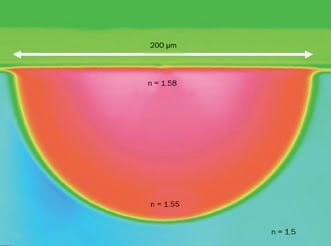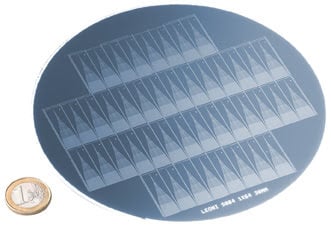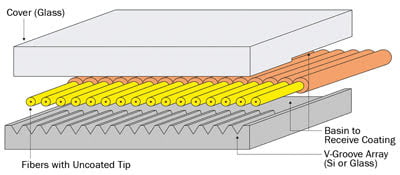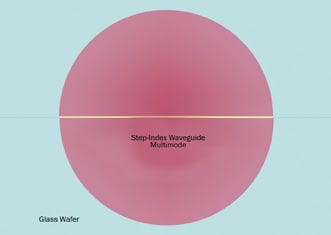Dr. Maria Kufner and Dr. Stefan Kufner, Leoni Fiber Optics GmbH, and Dr. Barbara Stumpp, Freelance Writer
A new generation of multimode splitters offers impressive features and performance for optical fibers used in data centers and other applications requiring large data transfer.
Optical waveguides have been the vanguard of data transmission for quite some time rather than copper cables, thanks to their distinctive advantages: They enable transmission rates in the range of terabits over up to several hundred kilometers without the use of regenerative repeaters. This means lighter cables, fewer repeaters and less required space, which reduces installation and maintenance costs significantly. There also is a lack of signal interference on neighboring fibers (crosstalk) and no influence from electromagnetic interference fields. Further, grounding and galvanic isolation of the connected components are not needed. These components ensure safe operation in a hazardous environment and provide high safety from interception.

Existing communication structures can be gradually replaced by optical fiber technology, as the new splitter can emulate the structures of the copper lines.
One previous disadvantage was the splitter technology, which was unwieldy and inflexible. Previously used fused couplers were formed by the simultaneous fusion and stretching of multiple fibers. The method is less flexible, more error-prone and works with only a very limited number of exits and entries. They also cannot be combined with arbitrary multimode fiber types. But a new process – originally developed for single-mode applications – manufactures compact splitters cost-efficiently and with great freedom of design. The components produced by this process can be used for larger wavelength ranges, are compact and allow a flexible design oriented by use with a high number of exits and entries. The waveguide can be tailored for different fiber types, and there is even space for multiple splitters on one single chip.
Efficient production
For this purpose, the process of forming the waveguide in terms of modal field, geometric cross section and numerical aperture must be adaptable to common fiber types. Next, it must offer a high degree of reproducibility and provide as little waste as possible.

During the process, only half of the future waveguide is generated in the surface of the glass substrate.
The process of generating these integrated planar waveguides resembles the production processes in microelectronics. In both cases, wafers are patterned photolithographically. However, the base material for the planar waveguide is a special kind of glass developed for ion diffusion processes.
Engineers can create waveguide structures using software tools and check the functionality through simulation. The design is then written into a photomask by an electron beam. The glass substrates structured by using the mask are then placed in a silver nitrate salt melt.
At the areas left free by the mask, the silver ions diffuse into the sodium-rich glass substrate and replace the sodium ions, increasing the refractive index within these areas. Applying an electric field simultaneously with salt contact accelerates the process. The shape of the spatial distribution of the silver ions is controlled by the process parameters, and, therefore, the mode field of the waveguide perfectly fits the selected fiber.

The process of ion exchange in glass makes the whole chip less interference-prone, and there is no fundamental limit to the number of entries and exits; in practice, the number of entries and exits varies in the range of up to 64 channels. Images courtesy of Leoni Fiber Optics.
The process can be controlled very precisely to create waveguide structures for very specific applications. Leoni previously produced waveguide structures with diameters up to 200 µm, but diameters up to 400 µm are possible. Depending on the complexity of the splitter, between one and 100 structures fit on a glass wafer – in the case of single-mode chips, possibly even more than 500.
During the process, only one-half of the future waveguide is generated in the surface of the glass substrate. To complete a waveguide, two mirror-inverted chip halves are joined.
The efficient coupling of the fibers to the planar-integrated waveguide requires V-groove arrays made of glass. These have a highly accurate distance from each other. In each V-groove, a fiber is placed and glued, creating fiber arrays that are then permanently bonded to waveguide chips.

V-groove arrays made of glass are used for the efficient coupling of the fibers to the planar-integrated waveguide; a fiber is placed and glued in each V-groove.
The process of ion exchange in glass generates complex waveguide structures monolithically integrated on one chip. This makes the whole assembly mechanically stable and less error-prone, and there is no fundamental limit to the number of entries and exits. In practice, this number is limited only by the chip size and the thickness of the fibers. By experience, the number of entries and exits required by the market varies in the range of up to 64 channels. Because of the large freedom of design of the process, a passive optical splitter and couplers can be realized in various configurations.
These components have low attenuation, high homogeneity, a high transparency over a wide spectral range, long-term stability and a compact design. Because the waveguide is integrated into the glass substrate, it has high mechanical and thermal stability.

To complete a waveguide, two mirror-inverted chip halves are joined.
Development continues
How well the mode field of the waveguide fits to that of the coupled optical fiber is important for the performance of a planar optical waveguide because any difference affects the coupling efficiency. With the new process, waveguides with a diameter up to 400 µm and numerical apertures of up to 0.5 can be realized. Thus, the waveguide chip can be combined with many of the common multimode fibers (quartz-quartz fiber, polymer-coated fibers, etc.). The process can be further optimized to open up new fields of application with advanced functionality.
Applications
In offices and data centers, large amounts of data are sent over short distances, a process that works better through optical fibers rather than via copper cables. Existing structures can be gradually replaced by optical fiber technology because the new splitter can emulate the structures of the copper lines. The industry has been using optical fibers for some time to direct the beam to multiple processing locations to operate multiple processing centers cost-effectively with one laser source – which, for example, plays a role in the microstructuring of surfaces. It also accelerates production. The bulky laser source can be placed “in the corner,” and the laser beam can be conducted via an optical fiber guide to the processing head in the hand of a robot, which then quickly and accurately welds in 3-D. As in medicine, it is easier and more precise to bring the laser beam to the exact treatment spot via waveguide. Waveguides perform other major operations in metrology, microscopy and spectroscopy.
Leoni’s multimode FiberSplit products are designed for working temperatures of –20 °C to 70 °C. The splitters work wideband and can be used in a wavelength range from 450 to 2000 nm. Maximum insertion loss and uniformity depend on the ratio of entries to exits. Thus, the maximum insertion loss for
1 x 2 splitters is in the range of 4 dB, with 1 x 16 splitters at 15 dB. The maximum uniformity of the distribution lies within 0.5 to 2.5 dB.
Even single-mode components produced by the previously used process are characterized by an extraordinary long-term stability, tested according to Telcordia GR 1209 and 1221 standards. The single-mode splitters installed in 1993-1994 in the OPAL projects of Deutsche Telekom show no changes in performance to date – and even survived the 2002 Elbe flood. Thanks to similar creation processes and comparable construction, the new multimode splitters are also compact, robust and stable over the long term.
Single-mode chips are used mainly in passive optical distribution networks of telecommunications (fiber to the home). Special planar lightguide components with optical functions such as couplers, interferometers or pitch converters are essential for optical measurement systems, sensors and optical signal processing.
Meet the authors
Dr. Maria Kufner is head of production and technology and the product line manager of planar lightwave circuits at Leoni Fiber Optics in Neuhaus-Schierschnitz, Germany; email: [email protected]. Dr. Stefan Kufner is manager of product engineering planar lightwave circuits at Leoni. Dr. Barbara Stumpp works as a freelance journalist in Europe and does public relations work for enterprises from the B2B areas; email: [email protected].